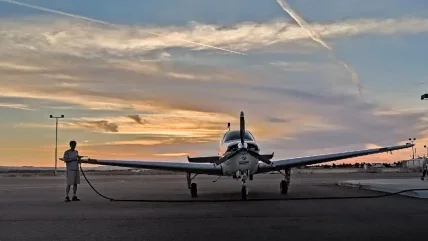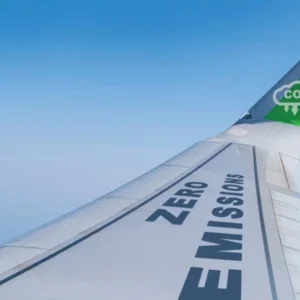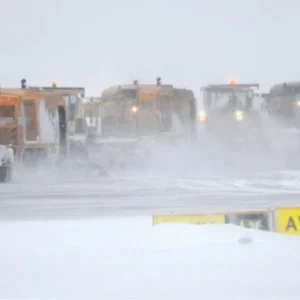
Billed as our ‘last best hope’ against the catastrophes of climate change, the delegates came, hoping to finally save our planet. By the time they had left the Victorian grandeur of Glasgow, almost two weeks later, COP26 had certainly resulted in some lofty statements – from wishing farewell to coal power to pledging $12bn against deforestation. And as it went for the Amazon, so too for aviation. Promising more efficient operators, COP26’s representatives also announced engine manufacturers would now be prodded towards reaching net-zero too. As Pete Buttigieg, the US transportation secretary, put it: “We are accelerating our action and commitments.”
All this sounds spectacular in theory, but what does it actually mean in practice? Like so much else at COP26, this is by no means a worthless question. After all, short of dusting off the world’s ocean liners, people still need to get around by plane. Considering aviation contributes around 2.5% of global carbon emissions – which may not sound like much, but is close to all of Africa’s – urgent action is clearly needed.
It is fortunate, then, that delegates in November 2021 also promoted the potential of so-called ‘sustainable aviation fuels’ (SAFs). Rather than being refined from traditional petroleum, SAFs instead rely on sustainable resources. More to the point, they hint at a world where the world’s aircraft can still soar without their passengers needing to feel any guilt.
Not, of course, that the path to a green future is necessarily straightforward. From high costs to supply issues, SAF evangelists – to say nothing of airports themselves – have plenty of work to do. That is even true when it comes to the ultimate efficacy of these fuels: they may be far better for the planet than fossil-based alternatives, but SAFs nonetheless come with a number of environmental handicaps. However, by liaising closely with fuel manufacturers, and building close relationships with airlines, staff are nonetheless making progress. Even so, it remains to be seen if the aviation industry can truly fulfil all the good words that came out of Glasgow.
Combusting old ideas
Even recently, sustainable fuels only represented a fraction of the aviation fuel market. According to work by the International Civil Aviation Organisation (ICAO), 2013–15 saw an average of just 0.29 million litres of SAF leave production lines each year. To put that into perspective, jet engines guzzled 360 billion litres of fossil fuels in 2019 alone.
Yet, speak to Stefan Häberlein and it is clear that change is coming fast – and he should know. As Munich Airport’s vice-president of corporate strategy and sustainability for the past decade, he has seen a dramatic rise in the use of SAFs, describing them as a “solution that can achieve complete de-carbonisation in aviation”. At any rate, this is reflected in the numbers. They may still be vastly outnumbered by fossil fuels, but 370,000 flights have used SAFs since 2016, with 100 million litres produced in 2021.
The reasons for this shift can be understood in several ways. Perhaps most important is the increasing environmental pressure on global aviation. Media-friendly summits like COP26 are undoubtedly part of the equation, as are tenacious campaigners like Greta Thunberg. But for Andrew Murphy, aviation director at the Transport and Environment campaign group, the real transformation happened in the minds of aviation insiders. “Eventually,” Murphy says, “the message got through that it’s not a case of being more efficient burning fossil fuels, and it’s not a case of offsetting your fossil fuel combustion.” The solution – the only solution – is “to stop combusting fossil fuels in the first place”. Certainly, this revelation could explain a new rush of industry initiatives. That includes mandatory quotas for renewable fuels, currently being discussed in Germany, as well as similar noises from the White House.
All this would mean little if SAFs themselves did not actually help the planet – but here too the industry is making progress. Traditionally, airlines have relied on so-called ‘biomass-to-liquid’ (BtL) fuels, whereby plant materials are turned into petrol. But, as Häberlein explains, while this approach is far superior to old-fashioned fossil fuels, it suffers from environmental drawbacks. Among other things, BtLs still emit greenhouse gases into the atmosphere. More recently, though, aviation has been investing in greener alternatives. A particularly exciting model is the ‘power-to-liquid’ (PtL) approach, which involves mixing sustainably sourced carbon dioxide and hydrogen. Nor, Häberlein emphasises, is this simply a scientific hypothetical. To take but one example, Airbus is now partnering with the SAF+ Consortium, a Canadian group, to secure wide-scale PtL production.
Fuel for the future
Munich Airport feels like the appropriate spot to launch an environmental revolution. Lying like a contented herd of cattle some 20 miles northeast of the city proper, it is surrounded by a greenbelt of over 5,000 hectares. Over 6,000 trees are planted here, and rich meadows share their bounty with sand lizards and bees. As long ago as 2010, the airport was the first in Germany to receive Airport Council International’s most prestigious carbon-busting prize. No wonder Häberlein describes Munich’s carbon policy as “a key component of our modern and sustainable corporate strategy” – something that now covers everything from battling noise pollution to fighting wind erosion.
To put it another way, Munich’s newest project – this time focused on SAFs – could almost be forgotten amid everything else the airport is promoting. But investigate the scheme further, and it soon becomes clear that it deserves special praise too. This is clear, if nothing else, in the airport’s remarkable attention to detail. Häberlein and his colleagues have erected Munich’s SAF infrastructure from scratch – for instance, by building a special tank farm to store sustainable fuel before it is needed by aircraft. That is echoed by close relationships with operators, with airport and airlines working together to check fuel for quality before it enters tanks. Nor are these checks purely for safety purposes. Häberlein and his team soon realised that fuels with SAF content of up to 50% could be pumped into planes without any fundamental infrastructure changes.
As that last point implies, integrating SAFs into a traditional fuel structure can be done relatively simply. “It can be mixed directly into fuel tanks,” emphasises Murphy. “Airports and fuel suppliers may want to monitor who uses the SAF – but it’s not a huge change for airports.” Certainly, this simplicity is reflected in the range of places introducing sustainable fuel to their stockpiles. Staying in the Federal Republic, for instance, Frankfurt and Stuttgart are just two of the German airports experimenting with SAF. Across the North Sea, Gatwick and Heathrow are following suit, something also true from Melbourne to Dubai. At the same time, Murphy argues that this enthusiasm is likely to continue if only because of the other benefits SAFs can offer operators. Obviously, being over 70% more carbon efficient than fossil fuels is nothing to sniff at. But in a world where costs are rising fast, the fact that SAFs can make plane engines more efficient surely explains their popularity too.
It should come as no surprise that where airlines go, other industries follow. Though SAF production has long been ruled by a few companies – the Finnish company Neste currently dominates Europe – the broad rise of sustainable fuels has seen competitors enter the fray. Häberlein, for his part, highlights OMV, a Viennese oil and petrochemical firm that recently announced it would supply SAF to Austrian Airlines. For Murphy, all this can only be for the good. Finally dragging sustainable fuel into the mainstream, demand could finally create a “stable environment” where investment increases and producers are encouraged to continue investing.
Work to be done
Given all this, it is tempting to imagine that SAFs will soon sweep fossil alternatives off the runway. But both Häberlein and Murphy sound a note of caution. The first potential problem is on the supply side. The SAF+ Consortium may be doing its best, but there are still no large-scale plants for PtL production. Nor can operators simply snap their fingers and expect a factory to appear overnight. To explain what he means, Murphy uses the example of electric vehicles. They may have become theoretically possible a decade ago – but are only really becoming popular now. That is reflected by the fact that PtL is currently the most expensive type of SAF, with Häberlein claiming it will only become the cheapest by the middle of this century.
If that does not put consumers off sustainable fuels – higher petrol costs means pricier tickets – more fundamental problems might arise instead. Though SAFs emit considerably fewer carbon emissions than across their whole production cycle, even PtLs produce CO2 when they are burnt. Naturally, that is not to say that SAFs are toast. On the contrary, Häberlein thinks passengers will be the “drivers” of their adoption, imperfect environmental outcomes notwithstanding.
Combined with industry and government efforts, the German seems confident that SAF will eventually take its rightful spot at fuel loading stations the world over. “Binding quotas may significantly increase the global SAF volume and change the decision-making on the use of SAF,” he says. “Legally binding quotas can lead to increased production and use of SAF in the future.” Given all the enthusiasm we heard in Glasgow in November 2021, we must certainly hope so.
2.5%
Percentage of global carbon emissions are contributed by the aviation industry, almost equivalent to the emissions produced by the African continent.
Our World in Data
100 Million
Litres of SAF produced globally in 2021.
370,000
Flights have used SAF between 2016–21.
International Air Transport Association
British Airways becomes first airline to use SAF produced at a commercial scale in the UK
British Airways (BA) has become the first airline in the world to start using SAF produced at a commercial scale in the UK, with the Phillips 66 Humber Refinery near Immingham, England, producing thousands of tonnes for BA flights. The SAF is produced from sustainable waste feedstock and is set to be added to the existing pipeline infrastructure that directly feeds several UK airports, including London Heathrow.
The sustainable aviation fuel bought by BA will reduce lifecycle CO2 emissions by almost 100,000t, which the company claims would be enough to power 700 net-zero CO2 emissions flights between London and New York on its fuel-efficient Boeing 787 aircraft. International Airlines Group (IAG), BA’s parent company, plans to invest $400m over the next two decades into the development of SAF, and BA has existing partnerships with several companies to develop plants and purchase the sustainable fuel.
“Our supplies of SAF from Phillips 66 Limited will allow us to progress with our ambitious roadmap to reach net zero carbon emissions by 2050 or sooner and will play a role in our commitment, as part of IAG, to power 10% of flights with SAF by 2030,” says Sean Doyle, chairman and CEO at BA.
“Progressing the development and commercial scale up of sustainable aviation fuel will be a game changer and crucial to reducing the aviation sector’s reliance on fossil fuels and improving the UK’s energy supply resilience. I’m confident that Britain can take a leading role on the global stage in this space, creating green jobs and export opportunities, if industry, developers and government continue to collaborate and make it a key focus area.”
Source: British Airways






